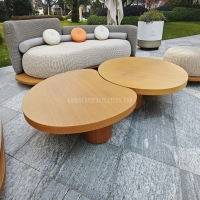Welcome to the website for landscape facilities products and knowledge.
What are the most important considerations for ensuring the table’s stability on decking?
Creating a comfortable and safe outdoor dining space on your deck requires careful attention to table stability. A wobbly table can lead to spills, damaged dishes, and even injuries, making it a critical factor for both functionality and safety. The most important considerations for ensuring your table's stability on decking begin with the surface itself. Decking is rarely perfectly level, and over time, wooden planks can warp or settle unevenly. Therefore, the first step is to assess the deck's surface and identify any significant slopes or uneven boards where the table legs will be placed.
The design and construction of the table are equally vital. A table with widely splayed legs or a broad, heavy base offers far greater inherent stability than a table with narrow, straight legs. The center of gravity is a key principle; a heavier tabletop or a lower-slung design is less likely to tip. For tables with adjustable feet, this feature is a significant advantage. You can individually adjust each leg to compensate for the deck's minor imperfections, effectively eliminating wobble and creating a perfectly level eating surface.
Furthermore, the interaction between the table legs and the decking material must be considered. Smooth metal or plastic legs can easily slide on composite or wooden decking, especially if the deck has a slight pitch. To prevent this, you can add non-slip pads or grippers to the bottom of each table leg. These simple, inexpensive accessories dramatically increase friction and prevent the table from shifting unexpectedly. For a more permanent solution on a wooden deck, you could even consider using small L-brackets to discreetly secure the table legs to the deck boards, though this limits mobility.
Environmental factors like wind should not be overlooked. In exposed areas, a lightweight table can become a hazard. Opting for a heavier material like cast iron or stone, or using a weighted tablecloth or a dedicated table weight system, can anchor the furniture securely. Finally, regular maintenance is crucial. Periodically check the tightness of bolts and screws on the table frame and re-adjust the leg levelers as the decking continues to settle with the seasons. By methodically addressing the deck surface, table design, leg grip, and environmental forces, you can ensure your table remains a stable and welcoming centerpiece for your outdoor gatherings.
Related search:

Recommendation
Elliptical metal outdoor table with nested design, resembling wood grain, round table